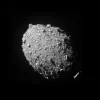NASA’s Curiosity Rover, which has been exploring Mars since 2012, made a significant discovery on May 30 that has perplexed scientists. The rover, which has been examining the Gale Crater, stumbled upon an unexpected substance while exploring a sulfate-rich region known as Gediz Vallis.
This area is notable for its potential to offer insights into Mars’ climatic history, as it is believed to contain minerals deposited by ancient water bodies.
The primary scientific hypothesis suggests that billions of years ago, water streams and ponds in Gale Crater left behind sulfur-based minerals as they dried up. This process might help explain the transition of Mars’ climate from a more Earth-like state to its current frozen desert condition.
The Curiosity Rover has previously found various minerals indicative of past water activity, such as magnesium sulfate, calcium sulfate, and sodium chloride.

However, two months ago, the rover made an unexpected discovery while navigating the salty terrain. It found a rock containing elemental, or pure, sulfur, which was revealed only after the rover accidentally cracked it open. This discovery was announced by NASA in a press release on July 18, highlighting the presence of yellow sulfur crystals within the rock.
Further analysis using the rover’s Mastcam and Alpha Particle X-ray Spectrometer confirmed the composition of the rock. Curiously, the rover did not find just one rock but an entire field of rocks made of pure sulfur. This discovery is puzzling because pure sulfur forms under a narrow range of conditions not previously associated with the Gale Crater’s geological history.
The unexpected presence of pure sulfur has left scientists like Ashwin Vasavada, Curiosity’s project scientist at NASA’s Jet Propulsion Laboratory, eager to uncover the reasons behind it. Vasavada likened the discovery to finding an oasis in the desert and emphasized the excitement and intrigue that comes with uncovering such planetary mysteries.
This discovery underscores the importance and excitement of planetary exploration, as it continually challenges and expands our understanding of other worlds.

